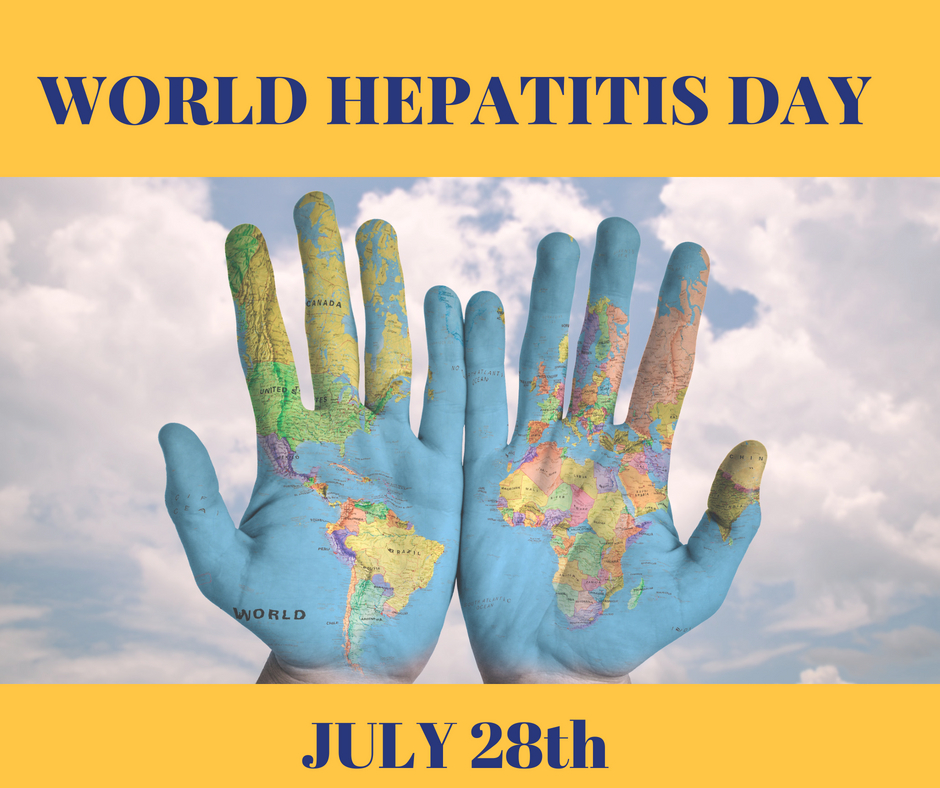
World Hepatitis Day — July 28th

World Hepatitis Day is recognized annually on July 28th. Organizations around the world, including The World Health Organization (WHO) and the Centers for Disease Control and Prevention (CDC), use World Hepatitis Day to raise awareness of the problem and what needs to be done to strengthen efforts in prevention, screening and control of viral hepatitis.
Viral hepatitis — a group of infectious diseases known as hepatitis A, B, C, D, and E — affects millions of people worldwide, causing both acute (short-term) and chronic (long-term) liver disease. The World Health Organization (WHO) data show an estimated 325 million people worldwide are living with chronic hepatitis B or chronic hepatitis C. Viral hepatitis causes more than one million deaths per year, a number comparable to deaths caused by tuberculosis and HIV combined. While deaths from tuberculosis and HIV have been declining, deaths from hepatitis are increasing.
What are the different types of hepatitis viruses occurring around the world?
The five hepatitis viruses – A, B, C, D and E – are distinct; they can have different modes of transmission, affect different populations, and result in different health outcomes.
Hepatitis A
Hepatitis A is primarily spread when someone ingests the virus from contact with food, drinks, or objects contaminated by feces from an infected person or has close personal contact with someone who is infected. Hepatitis A does not cause chronic liver disease and is rarely fatal, but it can cause serious symptoms. Hepatitis A can be prevented through improved sanitation, food safety, and vaccination.
Hepatitis B
Hepatitis B is often spread during birth from an infected mother to her baby. Infection can also occur through contact with blood and other body fluids through injection drug use, unsterile medical equipment, and sexual contact. The hepatitis B virus is common in sub-Saharan Africa, Asia and the Pacific Islands, but also has increased rates in the Amazon region of South America, the southern parts of eastern and central Europe, the Middle East and the Indian subcontinent. The hepatitis B virus can cause both acute and chronic infection, ranging in severity from a mild illness lasting a few weeks to a serious, chronic illness. If infected at birth or during early childhood, people are more likely to develop a chronic infection, which can lead to liver cirrhosis or even liver cancer. Getting the hepatitis B vaccine is the most effective way to prevent hepatitis B. WHO recommends that all infants receive the hepatitis B vaccine as soon as possible after birth, followed by 2-3 additional doses. In many parts of the world, widespread infant vaccination programs have led to dramatic declines of new hepatitis B cases.
Hepatitis C
Hepatitis C is spread through contact with blood of an infected person. Infection can occur through injection drug use and unsafe medical injections and other medical procedures. Mother-to-child transmission of hepatitis C is also possible. Hepatitis C can cause both acute and chronic infections, but most people who get infected develop a chronic infection. A significant number of those who are chronically infected will develop liver cirrhosis or liver cancer. With new treatments, over 90% of people with hepatitis C can be cured within 2-3 months, reducing the risk of death from liver cancer and cirrhosis. The first step for people living with hepatitis C to benefit from treatments is to get tested and linked to care. There is currently no vaccine for hepatitis C but research in this area is ongoing.
Hepatitis D
Hepatitis D is passed through contact with infected blood. Hepatitis D only occurs in people who are already infected with the hepatitis B virus. People who are not already infected with hepatitis B can prevent hepatitis D by getting vaccinated against hepatitis B.
Hepatitis E
Hepatitis E is spread mainly through contaminated drinking water. Hepatitis E usually clears in 4-6 weeks so there is no specific treatment. However, pregnant women infected with hepatitis E are at considerable risk of mortality from this infection. Hepatitis E is found worldwide, but the number of infections is highest in East and South Asia. Improved sanitation and food safety can help prevent new cases of hepatitis E. A vaccine to prevent hepatitis E has been developed and is licensed in China, but is not yet available elsewhere.
Hepatitis Risk Assessment
Take and share this 5 minute online Hepatitis Risk Assessment developed by the Centers for Disease Control and Prevention (CDC) which allows individuals to answer a series of questions and provides a personalized and tailored report of hepatitis testing and vaccination recommendations.
Source:
CDC


Most Commented